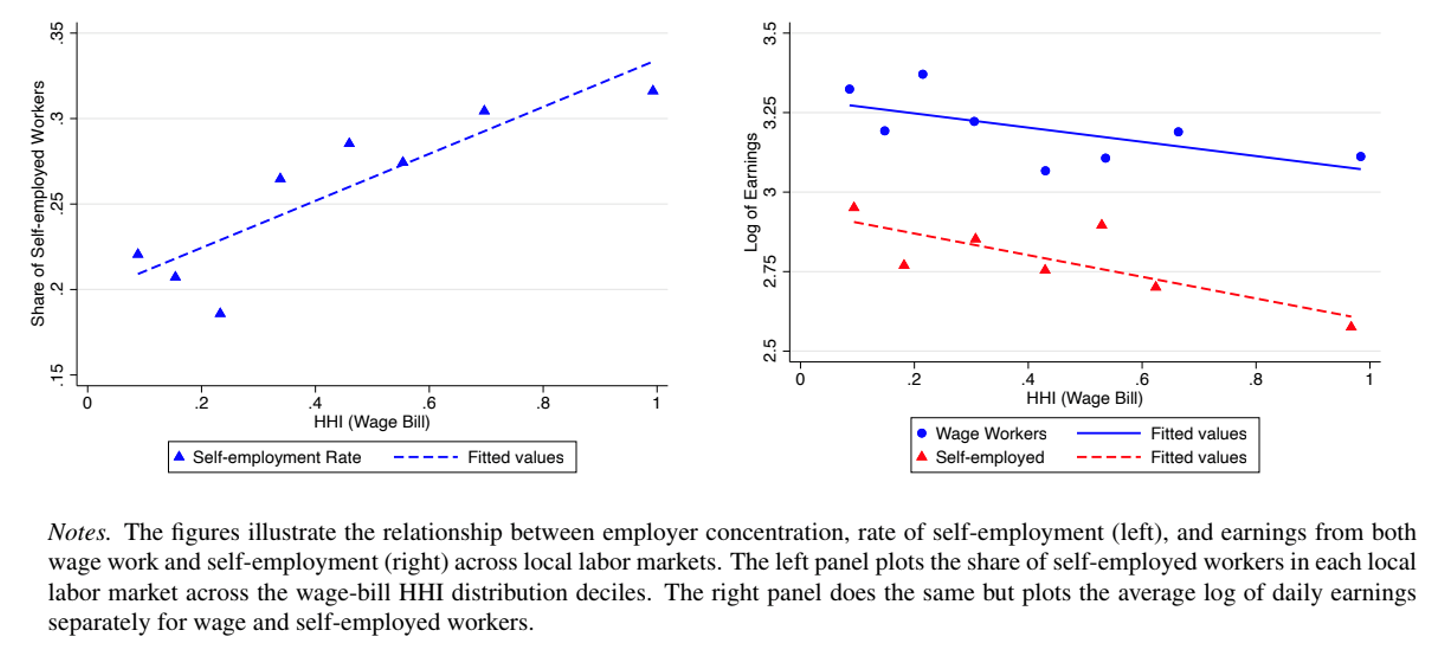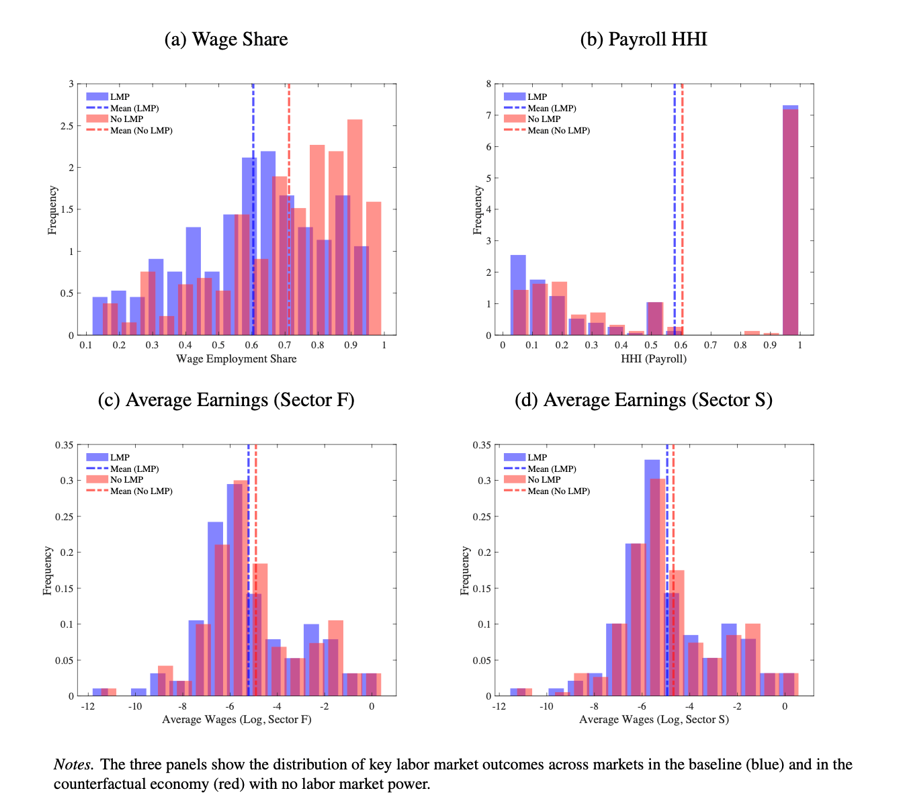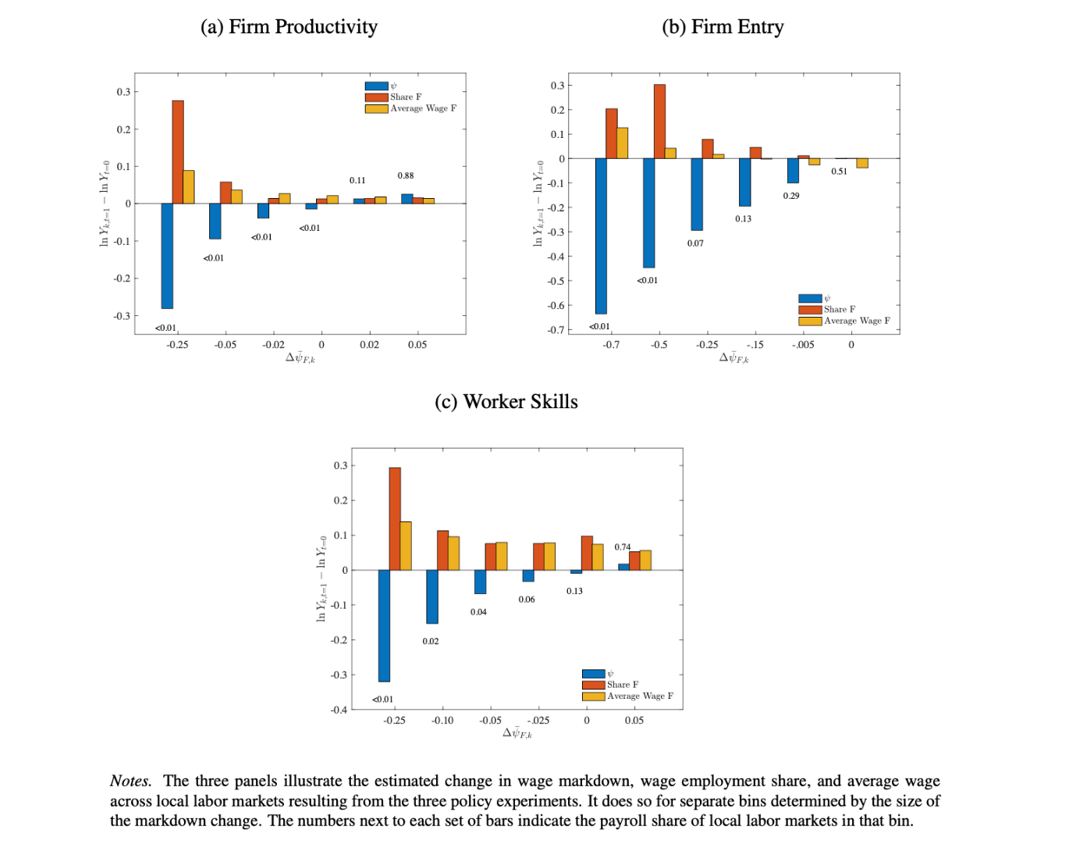
Labour market power hinders development by suppressing wage employment and also fostering a dependence on self-employment that undermines the effectiveness of policies aiming to boost wages and wage employment
In many developing countries, millions of people rely on informal self-employment for their livelihoods. Despite ongoing policy efforts to create stable, salaried jobs, self-employment remains widespread and employment opportunities at large firms stagnate, even amid growing GDP per capita (Diao et al. 2021, McMillan and Zeufack 2022, Poschke 2022). The enduring prevalence of self-employment and the lack of employment at large firms raise critical questions, the answers to which have significant implications for economic development.
In our research (Amodio, Medina and Morlacco 2023), we delve into the role of labour market power – specifically, the ability of employers to suppress wages below competitive levels. On the one hand, in lower-income countries, multiple barriers to firm entry and growth lead to concentration of salary employment among a limited number of employers. These firms have a significant impact on labour market outcomes, curbing job opportunities and suppressing wages to maximise profits. However, self-employment provides an appealing outside option for workers, especially when wage job opportunities are scarce, thereby reducing the wage-setting power of firms. The interplay between employers’ wage-setting power and self-employment shapes labour market outcomes, potentially reducing the effectiveness of industrial policy.
Concentration, self-employment, and labour market power in Peru
Our study focuses on Peru, whose labour market characteristics align with those of many other low- and middle-income countries (Donovan et al. 2023). Using data on medium and large manufacturing firms along with worker-level data, we characterise Peruvian local labour markets, as defined by 24 manufacturing 2-digit sectors across 199 different geographical units.
Our analysis provides several key insights. First, in a typical local labour market, employment and wages tend to be highly concentrated among a few employers. Second, self-employment is prevalent, constituting 40% of the manufacturing workforce. Third, workers switch frequently between wage work and self-employment, especially those at the bottom of the self-employment earning distribution. Fourth, as shown in Figure 1, concentration and self-employment exhibit a strong positive correlation across markets, and higher concentration is associated with lower wages and lower self-employment earnings. These relationships persist even conditional on time-invariant location and industry characteristics, as well as overall time trends.
Figure 1: Concentration, self-employment rate, and earnings

Next, we delve into the measurement of labour market power and its variation across markets. To do this, we use the staggered rollout of a rural electrification programme and its differential impact across firms which faced different constraints to electricity access at baseline. Electrification boosts labour demand differentially for these firms, and their wage and employment responses allow us to directly measure their wage-setting power - by tracing out the slope of the “residual labour supply curve” (Manning 2003).
We find that labour market power is substantial in Peru, with manufacturing workers only receiving about 70 cents as a wage for every additional dollar produced. This is close to what Amodio and De Roux (2022) find in Colombian manufacturing and what Deb et al. (2022) and Yeh et al. (2022) find for US manufacturing. It is however higher than what Felix (2022) finds for Brazil prior to the 1990s trade liberalization (wage take-home share of 50%).
Notably, the firms' wage-setting power across labour markets correlates with self-employment opportunities. While wage-setting power increases with concentration, this relationship is weaker in markets where self-employment is more prevalent. We estimate labour market power to be largest in markets with high concentration and low self-employment rates, where workers receive only 57 cents for each marginal dollar produced.
Policy lessons
To make sense of these facts, we build a general equilibrium model of the Peruvian economy, which we conceptualise as a collection of local labour markets (for a simple explanation of the model, please see footnotes). We then estimate the model using data from Peru to conduct two sets of policy experiments.
Figure 2: Effects of labour market power

First, we counterfactually eliminate labour market power of employers to estimate how it is currently shaping key labour market outcomes. As shown in Figure 2, the share of wage employment would increase by over ten percentage points - from 60% to 71% - if labour markets were perfectly competitive, while wages and earnings from self-employment would increase by 31% and 27%, respectively. Crucially, we find that labour market power not only decreases earnings from wage employment by suppressing wages but also results in a decline in average earnings from self-employment. This is because the reduction in opportunities for wage employment prompts lower-skilled workers to choose self-employment, reducing average earnings within that sector.
Figure 3: Effects of policy shocks across markets

In our second experiment, we investigate whether labour market power, and its connection to self-employment, hinders policies aiming to boost wages and wage employment. We examine three policy categories: (i) enhancing firm productivity (McCaig and Pavcnik 2018, Fiorini et al. 2021); (ii) reducing fixed entry costs for employers by simplifying business registration regulations (Kaplan et al. 2011, Bruhn 2011); and (iii) improving workers’ skills (McKenzie 2017, Alfonsi et al. 2020).
We calibrate the size of policy interventions based on actual policies implemented in Peru and Mexico and assess their labour market implications both at baseline and in a counterfactual world where firms act as wage-takers. A difference-in-differences approach allows us to identify the impact of labour market power on these policies’ effectiveness.
Figure 3 shows the differential impact of these policies on wage-setting power, wage employment shares, and wages across markets in the two economies. We find that average income from wage employment increases only when the policy substantially reduces labour market power, a rare occurrence. In most cases, the expansion of wage employment increases labour market power by diminishing the workers’ labour supply elasticity, leading to a reduction in wage employment and wages. Consequently, these policies are significantly less effective than if labour markets were perfectly competitive. We estimate that, without labour market power, policies aimed at enhancing firm productivity or worker skills could nearly double their effects on labour income.
Concluding remarks
By examining labour market power and its connection to self-employment, our study reveals the intricate dynamics shaping the economic landscapes of many low and middle-income countries. We identify a dual role of self-employment in such contexts: acting as a shield for workers against the dominance of large firms while also posing a challenge to the effectiveness of policies aimed at promoting wage employment. Thus, labour market power hinders the development process not only by suppressing wage employment, but also by fostering a dependence on self-employment that undermines policy effectiveness. It is therefore essential for policymakers to develop new approaches that consider the intricate relationship between labour market power, self-employment, and industrial development.
References
Alfonsi, L, O Bandiera, V Bassi, R Burgess, I Rasul, M Sulaiman, and A Vitali (2020), “Tackling youth unemployment: Evidence from a labor market experiment in Uganda,” Econometrica, 88(6): 2369–2414.
Amodio, F, and N De Roux (2022), “Measuring Labor Market Power in Developing Countries: Evidence from Colombian Plants,” Journal of Labor Economics, forthcoming.
Amodio, F, P Medina, and M Morlacco (2023), “Labor Market Power, Self-Employment, and Development,” Mimeo.
Bruhn, M (2011), “License to Sell: The Effect of Business Registration Reform on Entrepreneurial Activity in Mexico,” The Review of Economics and Statistics, 93(1): 382–386.
Deb, S, J Eeckhout, A Patel, and L Warren (2022), “What drives Wage Stagnation: Monopsony or Monopoly?” Journal of the European Economic Association, jvac060.
Diao, X, M Ellis, M S McMillan, and D Rodrik (2021), “Africa’s Manufacturing Puzzle: Evidence from Tanzanian and Ethiopian Firms,” National Bureau of Economic Research, Inc NBER Working Papers 28344.
Donovan, K, W J Lu, and T Schoellman (2023), “Labor Market Dynamics and Development,” Quarterly Journal of Economics, forthcoming.
Felix, M (2022), “Trade, Labor Market Concentration, and Wages,” Mimeo.
Fiorini, M, M Sanfilippo, and A Sundaram (2021), “Trade liberalization, roads and firm productivity,” Journal of Development Economics, 153(C).
Kaplan, D S, E Piedra, and E Seira (2011), “Entry regulation and business start-ups: Evidence from Mexico,” Journal of Public Economics, 95(11): 1501–1515.
Manning, A (2003), “Monopsony in Motion: Imperfect Competition in Labor Markets,” Princeton University Press.
McCaig, B, and N Pavcnik (2018), “Export Markets and Labor Allocation in a Low-Income Country,” American Economic Review, 108(7): 1899–1941.
McKenzie, D (2017), “How Effective Are Active Labor Market Policies in Developing Countries? A Critical Review of Recent Evidence,” The World Bank Research Observer, 32(2): 127–154.
McMillan, M, and A Zeufack (2022), “Labor Productivity Growth and Industrialization in Africa,” Journal of Economic Perspectives, 36(1): 3–32.
Poschke, M (2022), “Wage employment, unemployment and self-employment across countries,” Mimeo.
Roy, A D (1951), “Some thoughts on the distribution of earnings,” Oxford Economic Papers, 3(2): 135–146.
Yeh, C, C Macaluso, and B Hershbein (2022), “Monopsony in the US Labor Market,” American Economic Review, 112(7): 2099–2138.
A simple explanation of our model
Within each market, a finite number of firms compete to attract workers who, in turn, decide whether to work for a wage or be self-employed. Worker sorting depends on comparative advantage and posted wages, as in the standard Roy (1951) model. A higher wage prompts more workers to opt for wage employment, resulting in an upward-sloping supply of wage work, which non-atomistic firms internalize. Despite productivity differences among firms, they are perceived as perfectly substitutable from the workers' perspective and all pay the same wage, as in a textbook Cournot oligopsony model. In equilibrium, the average wage markdown in the labour market increases with employer concentration and decreases with the supply elasticity of wage work. Concentration depresses wages, prompting more workers to choose self-employment. However, those who stick to wage employment are more responsive to changes in the wage paid, which lower labour market power. The situation reverses when wage employment becomes more attractive and expands, possibly due to policy efforts.



